#textile recycling adelaide
Text
Is Your Closet Overflowing? Discover Textile Recycling in Adelaide
Clothing and textile waste is a growing concern, especially with the rise of fast fashion. Many of us find our closets overflowing with clothes that we no longer wear or need. This not only clutters our living spaces but also contributes to environmental pollution. If you’re living in Adelaide and facing this problem, there's an effective solution: textile recycling. At TERRESA Recycling, we offer comprehensive textile recycling services to help you manage your wardrobe waste responsibly.
The Problem with Textile Waste
Textile waste is a significant environmental issue. The fashion industry is one of the largest polluters in the world, and the rapid production of cheap clothing has led to an increase in discarded garments. Most textiles end up in landfills, where they can take years to decompose, releasing harmful chemicals and greenhouse gasses into the environment. By choosing textile recycling in Adelaide, you can play a part in reducing this waste and its detrimental impact on the planet.
How Textile Recycling Works
Textile recycling involves collecting unwanted clothes and fabrics, sorting them based on their condition, and processing them for reuse or repurposing. At TERRESA Recycling, we make this process easy and accessible for Adelaide residents. You can bring your old clothes, linens, and other textiles to our facility, where they will be carefully sorted. Usable items are donated to charities, while damaged textiles are broken down and recycled into new products, such as insulation materials, cleaning cloths, and even new fabrics.

Benefits of Textile Recycling
Choosing textile recycling in Adelaide has numerous benefits. Firstly, it helps reduce the amount of waste sent to landfills, decreasing environmental pollution. Recycling textiles also conserves resources, as it reduces the need for raw materials to produce new fabrics. Additionally, by donating usable clothes, you support local communities and charities, providing clothing to those in need.
TERRESA Recycling: Your Partner in Sustainability
At TERRESA Recycling, we are committed to promoting sustainability and environmental responsibility. Our textile recycling program is designed to be convenient and efficient, making it easy for Adelaide residents to participate. Whether you have a few items or an entire wardrobe to recycle, we are here to assist you. Our team is dedicated to ensuring that as many textiles as possible are repurposed and kept out of landfills.
How to Get Started
Getting started with textile recycling in Adelaide is simple. Visit our TERRESA Recycling facility with your unwanted textiles, and we’ll take care of the rest. We accept a wide range of items, including clothing, shoes, bags, and household textiles. By choosing to recycle your textiles, you’re making a positive impact on the environment and supporting a sustainable future.
Conclusion
Textile waste is a pressing issue, but with the right steps, we can all contribute to a solution. If your closet is overflowing with clothes you no longer wear, consider textile recycling in Adelaide. TERRESA Recycling is here to help you manage your textile waste responsibly and sustainably. Together, we can reduce waste, conserve resources, and support our community. Visit us today and take the first step towards a greener future.
0 notes
Text
Car Battery Recycling in Adelaide: A Step Towards Sustainability
Car battery recycling is a critical component of environmental conservation and resource management in Adelaide. Car batteries contain hazardous materials that can cause significant environmental harm if not disposed of correctly. By recycling these batteries, Adelaide not only mitigates environmental risks but also contributes to the sustainable use of valuable materials. Here’s an in-depth look at the benefits, process, and key players in car battery recycling in Adelaide.
Benefits of Car Battery Recycling
Environmental Protection:
Reduction of Toxic Waste: Car batteries contain lead, acid, and other toxic materials that can contaminate soil and water. Proper recycling prevents these hazardous substances from entering the environment.
Conservation of Resources: Recycling allows the recovery of valuable materials such as lead and plastic, which can be reused in new batteries and other products. This reduces the need for raw material extraction.
Economic Advantages:
Cost Savings: Recycling car batteries is often cheaper than producing new ones from raw materials. These cost savings can be passed on to consumers.
Job Creation: The recycling industry provides employment opportunities in Adelaide, from collection and transportation to processing and manufacturing.
Regulatory Compliance:
Adherence to Laws: Proper disposal and recycling of car batteries help businesses and individuals comply with local and national environmental regulations, avoiding potential fines and legal issues.
The Car Battery Recycling Process
Collection:
Car batteries are collected from various sources, including automotive shops, recycling centers, and individual consumers. Many retailers and service centers offer battery take-back programs.
Transportation:
The collected batteries are safely transported to recycling facilities. Proper handling and transportation are crucial to prevent leaks and spills.
Sorting and Inspection:
At the recycling facility, batteries are sorted and inspected to ensure they are suitable for recycling. This step involves identifying different types of batteries and separating any that are damaged or non-recyclable.
Dismantling:
The batteries are then dismantled, separating the components such as lead, plastic, and acid. Specialized equipment and processes are used to safely handle and break down the batteries.
Lead Processing:
The lead components are melted and purified to remove impurities. The refined lead is then cast into ingots, which can be used to manufacture new batteries.
Plastic Recycling:
The plastic cases of the batteries are cleaned and processed into pellets. These pellets can be used to produce new battery cases or other plastic products.
Acid Neutralization:
The acid from the batteries is neutralized and treated. Some facilities convert the acid into sodium sulfate, which can be used in laundry detergents, glass, and textiles.
Manufacturing:
The recovered materials are supplied to manufacturers to produce new car batteries and other products, closing the recycling loop.
Leading Car Battery Recycling Services in Adelaide
Several reputable companies in Adelaide specialize in car battery recycling, ensuring safe and efficient processing. Notable organizations include:
Battery World: Known for their comprehensive battery recycling services, Battery World offers convenient drop-off locations across Adelaide.
Century Yuasa: A leading battery manufacturer and recycler, Century Yuasa operates extensive recycling programs to recover valuable materials from used batteries.
EcoCycle: EcoCycle provides specialized recycling services for various types of batteries, including car batteries, focusing on environmental sustainability.
Conclusion
Car battery recycling in Adelaide is an essential practice that supports environmental protection, resource conservation, and economic efficiency. By understanding the benefits and engaging in proper recycling practices, individuals and businesses can contribute to a sustainable future. With reliable recycling services available across the city, Adelaide is well-equipped to handle the challenges of car battery disposal and ensure a greener tomorrow.
0 notes
Text
What Makes Waterjet Cutting in Adelaide Superior to Traditional Methods?
Waterjet cutting technology has transformed the fabrication industry, providing numerous advantages over traditional cutting methods. For businesses in Adelaide, this technology offers enhanced precision, efficiency, and versatility, making it the preferred choice for many applications. In this blog, we will explore the benefits of waterjet cutting and why it stands out as a superior method, particularly when partnered with the expertise of Stressfree Waterjet.
Precision and Accuracy
One of the most significant advantages of waterjet cutting in Adelaide is its exceptional precision. Waterjet cutters use a high-pressure stream of water, often mixed with abrasive materials, to slice through a variety of materials with incredible accuracy. This method can achieve tolerances as tight as ±0.1 mm, which is challenging to match with conventional cutting techniques. Whether working with metals, ceramics, glass, or composites, waterjet cutting ensures clean and precise edges without the need for secondary finishing processes. At Stressfree Waterjet, we leverage this precision to deliver top-notch results for our clients, ensuring their projects meet the highest standards.

Versatility in Material Cutting
Traditional cutting methods often face limitations when dealing with different types of materials. In contrast, waterjet cutting can handle almost any material, from soft textiles to hard metals. This versatility makes it an ideal choice for a wide range of industries, including aerospace, automotive, construction, and artistic applications. Stressfree Waterjet utilizes this capability to provide high-quality cuts for diverse projects, ensuring that each client's specific needs are met with precision and efficiency. The ability to cut various materials with the same equipment saves time and resources, making waterjet cutting a cost-effective solution.
No Heat-Affected Zones
Unlike laser or plasma cutting, waterjet cutting does not generate heat during the cutting process. This absence of heat means that the material's properties remain unchanged, preventing issues such as warping, melting, or material weakening. For projects that require maintaining the integrity of the material, such as in the aerospace or medical device industries, waterjet cutting in Adelaide is the superior choice. By avoiding heat-affected zones, Stressfree Waterjet ensures that your materials retain their original properties, leading to better performance and longevity.
Environmental and Safety Benefits
Waterjet cutting is an environmentally friendly option compared to traditional methods. It produces minimal waste, as the cutting process can be precisely controlled to minimize excess material. Additionally, the water and abrasive materials used in the process can be recycled, reducing the environmental impact. Safety is another critical advantage. Since waterjet cutting does not produce hazardous fumes or require the use of toxic chemicals, it creates a safer working environment for operators and reduces the overall risk associated with fabrication processes. Stressfree Waterjet is committed to maintaining high safety standards and minimizing our environmental footprint.
Cost-Effectiveness
While the initial investment in waterjet cutting equipment might be higher, the long-term benefits make it a cost-effective solution. The precision of waterjet cutting reduces the need for secondary operations, saving time and labor costs. Additionally, the ability to cut a wide variety of materials with a single machine eliminates the need for multiple cutting tools, further reducing expenses. Stressfree Waterjet offers competitive pricing and efficient cutting services, ensuring that businesses in Adelaide can achieve high-quality results without breaking the bank. Our commitment to affordability and quality makes us a trusted partner for your fabrication needs.
Customization and Flexibility
Waterjet cutting offers unmatched flexibility and customization options. With advanced software and CNC technology, intricate designs and complex shapes can be easily achieved. This flexibility allows for rapid prototyping and quick turnaround times, enabling businesses to bring their ideas to life efficiently. Whether you need a single prototype or a large production run, waterjet cutting in Adelaide provides the adaptability required to meet diverse project demands. Stressfree Waterjet excels in delivering customized solutions tailored to your specific requirements.
Conclusion
In conclusion, waterjet cutting in Adelaide offers significant advantages over traditional cutting methods, making it the preferred choice for many industries. The precision, versatility, and environmental benefits, coupled with cost-effectiveness and customization capabilities, make it an invaluable tool for modern fabrication projects. Stressfree Waterjet is committed to delivering top-notch waterjet cutting services, ensuring that every project is completed to the highest standards of quality and accuracy. By choosing waterjet cutting and partnering with Stressfree Waterjet, you can elevate the quality and efficiency of your fabrication projects. Embrace the future of cutting technology and experience the difference that waterjet cutting can make for your business.
0 notes
Text
Dispose your batteries correctly and help make the earth a better place
If you are wondering how to recycle batteries, Adelaide is the city for you. You can take your batteries to SA Battery Sales and Recycling, a specialist Used Lead Acid Battery recycling centre. The company collects ULAB scrap from all areas of Adelaide. As these batteries contain toxic materials, it is important to recycle them correctly to keep them from contaminating our environment or causing fines and penalties. If you are considering battery recycling as an option for your old batteries, you should know that there are several options available for you.
Most Australians dispose of their used batteries in the household garbage, but if you were to take them to a battery recycling facility, that would save you money and the environment. It is also possible to drop off your used household batteries at ALDI stores, which have B-cycle battery recycling bins at the front of the stores. The collection bins accept rechargeable and non-rechargeable household batteries.
In addition to battery recycling services, Cyber Recycling has launched a national program to recycle all kinds of batteries. They accept rechargeable and single-use batteries, as well as mobile phones and laptops. You can visit one of their stores to drop off your used batteries for free. You can also recycle them in your workplace. There are many convenient locations throughout the country. These recycling facilities can be used for all types of batteries, including lithium batteries.
When it comes to lead-acid batteries, there are two basic ways to recycle them. The first option is to use baking soda and water to neutralise the acid, which turns the battery into water. The waste is then treated in wastewater treatment facilities. The second option is to convert the battery into sodium sulphate. The sodium sulphate is used for various purposes, including glass, textile creation, and cleaning.
Lead acid batteries are typically used in cars and boats. These batteries are classified as hazardous waste under the Hazardous Waste Act 1989, because they contain lead compounds and sulfuric acid. These batteries are also valued as e-waste, as 98% of them can be recycled into new products. The process starts all over again. You can donate your old batteries to charities and recycle them as part of your local community. So, why not recycle your old batteries in adelaide and help the environment?
Source: https://sites.google.com/view/free-e-waste-recycling/dispose-your-batteries-correctly-and-help-make-the-earth-a-better-place
0 notes
Text
An 1870s Church Turned Stylist’s Family Home!
An 1870s Church Turned Stylist’s Family Home!
Homes
by Lucy Feagins, Editor
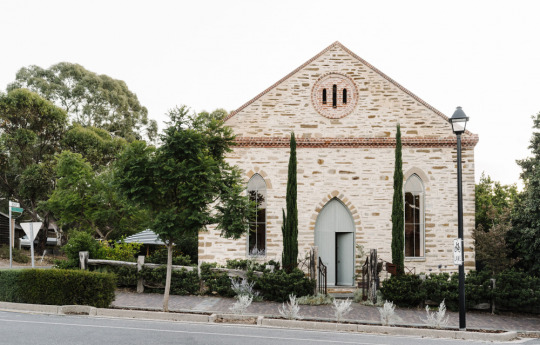
This is the exterior of the church on the High Street of Willunga. The family added the windows after obtaining permission from State Heritage. Photo – Marnie Hawson.
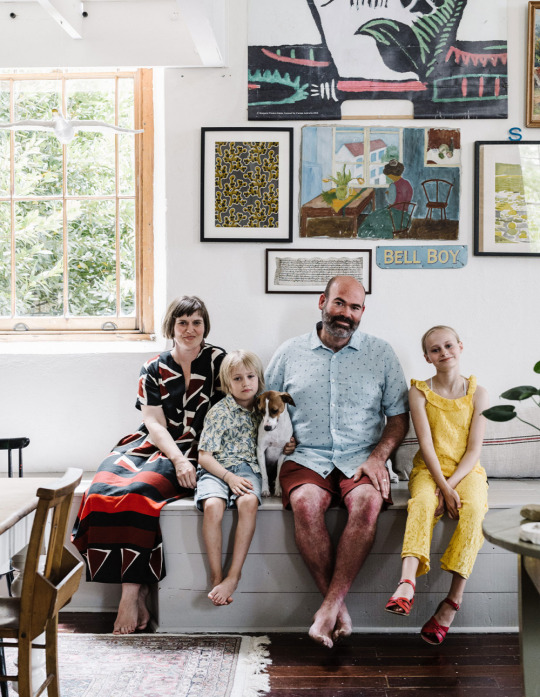
The fam! Large Margaret Preston exhibition banner bought when Sarah worked at the Art Gallery of SA bookshop. Painting found in a Swedish op-shop. Photo – Marnie Hawson.
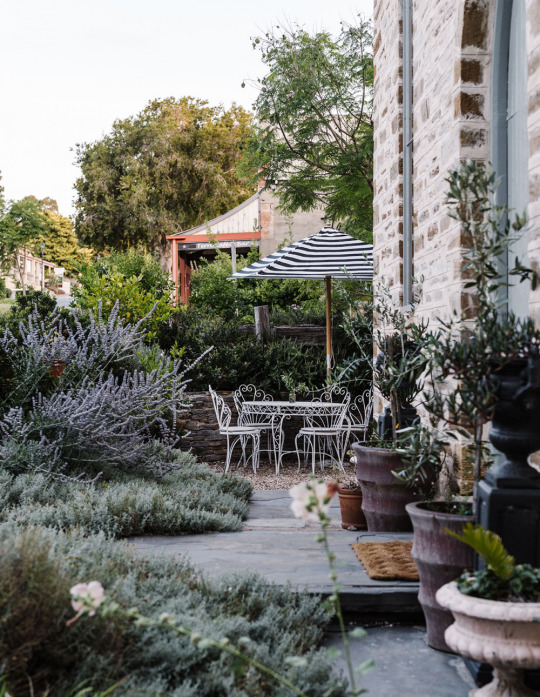
The front courtyard houses a vintage outdoor setting bought on Gumtree. There is a cafe on one side and a glass studio on the other. Photo – Marnie Hawson.

The mezzanine with steel staircase, designed and built by Adam. The family clad the newly built walls in v-groove panelling to contrast with the stone walls, which are painted in Dulux Antique White USA. The long picture above the dresser is a vintage temple rubbing. The coffee table is from @danishvintagemodern. The ‘Tessa’ chair was bought on Gumtree. Photo – Marnie Hawson.

The dining area is tucked under the mezzanine; it has been kept deliberately art-free. Black Danish chairs found on Gumtree find and re-painted. Photo – Marnie Hawson.
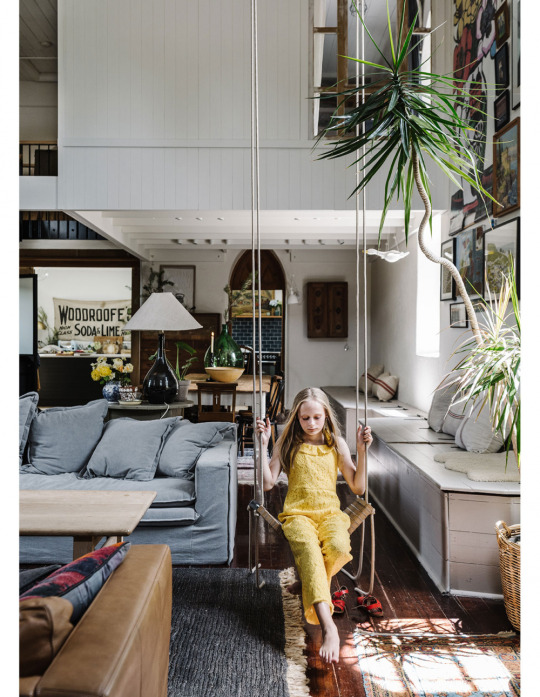
The original jarrah floors were a non-negotiable keeper! Swing from Etsy. Linen couch from Living By Design. Rug by Armadillo and Co. Photo – Marnie Hawson.
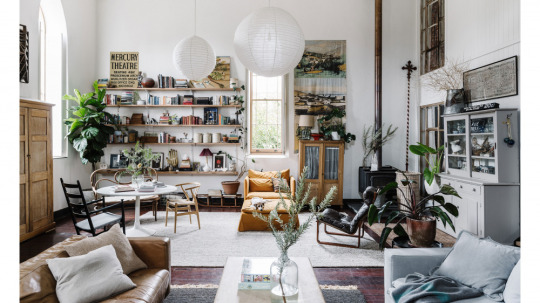
The large wall hanging to the right of the window are lithographs made by the Religious Tract Society in London for churches and Sunday schools. Sarah and Adam found the large European processional staff at Scammells Auctions. Linen couch from Living By Design. Rug by Armadillo and Co. Photo – Marnie Hawson.
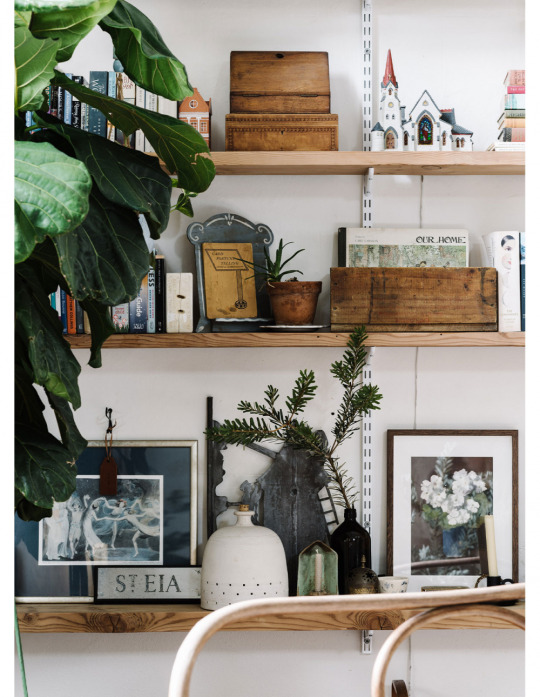
A print of a William Blake etching that used to hang in Sarah’s bedroom when she was growing up. The tiny church lamp was a gift from Sarah’s sister Emma (the other half of Read & Hall) when Sarah bought the church. Floral painting from the Camberwell market. Photo – Marnie Hawson.

Adam and Sarah built the shelves from recycled Oregon timber and Bunnings brackets. Vintage ‘Sebel’ table, still-life and bentwood bench found on Gumtree. Freedom rug. The theatre sign was from the State Theatre Company auction. Lanterns from The Society Inc. Photo – Marnie Hawson.

In winter the family move the couches closer to the fire on the other side of the living room. The painting of the fairground (top right on the gallery wall) is by Cornish artist Michael Quirke. The tin horses were found in an antique shop in Tilba Tilba, NSW. The lady holding the teacup painting is by South Australian artist Zoe Freney. The castle on the cliff is by G. W. Hill. Green hills screenprint by Svenston Ehmen (1957). Photo – Marnie Hawson.

Adam mixes records in this room where the acoustics are amazing. The painting is an altar backdrop painted by Karl Forup in 1932 for the Church of Daniel in Copenhagen, which is no longer there. Sarah found it for sale in someone’s shed contents when sourcing for Read & Hall Traders and looked up the history. Vintage Ikea rocker recovered in boucle fabric. Photo – Marnie Hawson.

Giant lamp is from Pottery Barn Australia. Large nautical signal flag bought on eBay. Large Bauhaus print found on Etsy. Textile artwork near lamp is by Irish artist Rosemary Cullen. Photo – Marnie Hawson.
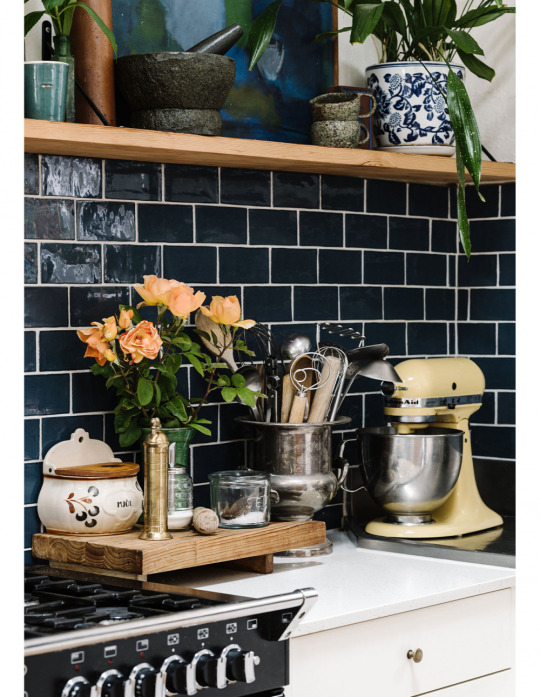
Pepper grinder by Alexander Mill bought at Mr Kitly. Photo – Marnie Hawson.
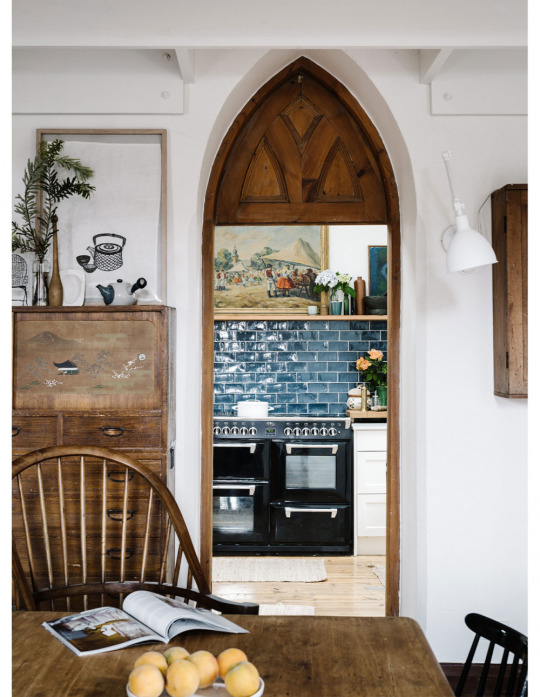
One of the three original arched doors in the church. The screenprint was a gift from Adelaide printmaker Georgia Cheeseman. Photo – Marnie Hawson.
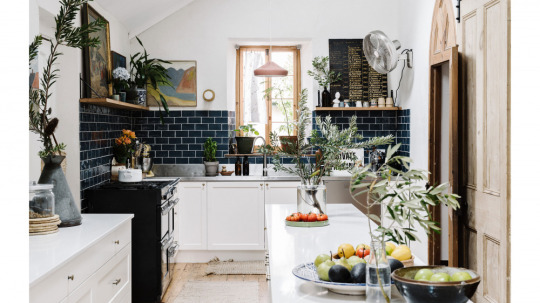
Original Baltic pine doors. The painting to the left of the window is by Danish artist Orla Petersen bought at Scammells Auctions in Adelaide. Photo – Marnie Hawson.

Kitchen details. The painting to the right of the banner is by T. Ringdahl and was bought at a charity shop in Sweden. Photo – Marnie Hawson.

The vintage shop banner was purchased years ago from Scammells Auctions . Sarah and Adam hope to put a window here to the backyard when they do the next extension. Photo – Marnie Hawson.
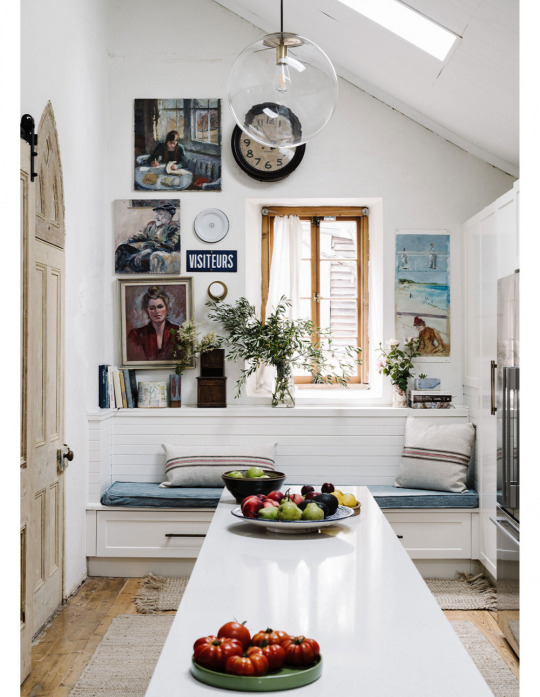
The long skinny kitchen is 9 x 3.5 metres. Sarah designed the kitchen island after watching Sense & Sensibility and saw one she loved. The female portrait is by Sandra Rose and belonged to Sarah’s mum. The male portrait above her is by Anna Po painted int 1972. Painting of a girl writing is by A. Bredsdorff in 1928 and was bought by Adam at Scammells Auctions. The painting on the right is by Adam’s sister Alex Linden while she was at art school and is a copy of Holiday at Mentone by Charles Conder. Photo – Marnie Hawson.
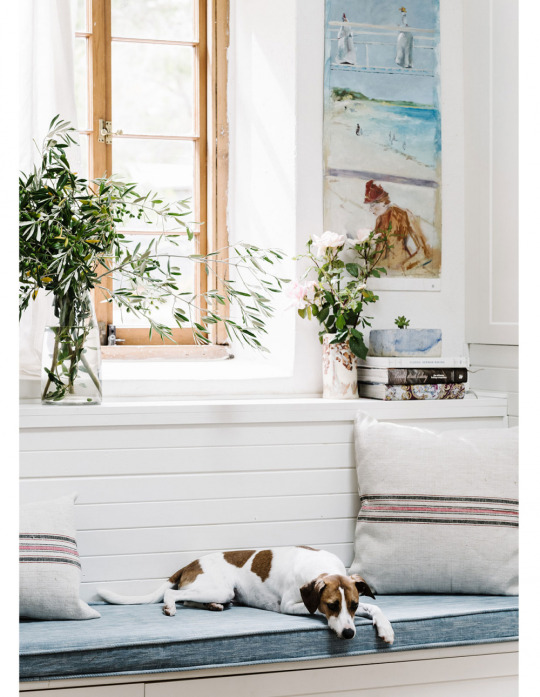
Alfie on the kitchen day bed. The french style cushions are made by Sarah and her sister Emma from vintage French fabric, which they sell at Read & Hall Traders. Photo – Marnie Hawson.
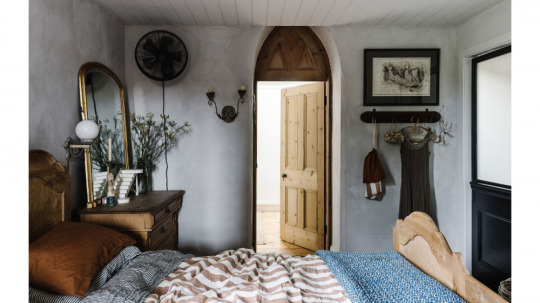
Our petite bedroom with original carved Baltic pine door. The wall lamp by the bed was bought Vintage Carousel SA. The tiny white staircase on the chest of drawers is from a flea market in Paris. Photo – Marnie Hawson.

Old windows from a factory in Amsterdam bought from Fossil Vintage. This window open to the fireplace in the main living space. Photo – Marnie Hawson.

The bed was made by joining two Swedish single beds found on marketplace into a king size bed. Covered in Society of Wanderers linen. The side table is an old washstand with a terrazzo top. Painting was bought in an antique shop in Copenhagen and is by Danish artist Louis Moe. Brass Russian lamp from Gumtree. Photo – Marnie Hawson.
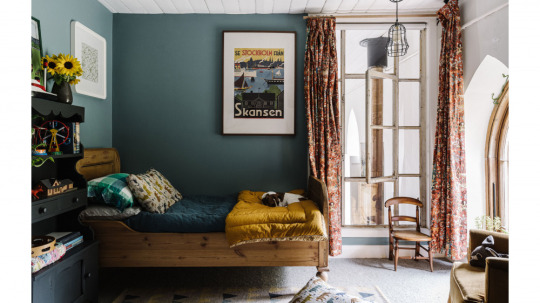
Arlo’s bedroom with another of the Fossil Vintage windows. The print was bought at a gift store in Stockholm. Tiger cushions made with fabric from The Drapery. Animal-printed vintage curtains from Gumtree. Photo – Marnie Hawson.
Sarah and Adam Fairhead Hall knew of this old church in Willunga, South Australia, having regularly visited Sarah’s sister in the town. When they learned the property was for sale, they put in an offer and crossed their fingers, and finally five months later, their offer was accepted!
The heritage listed former Church Of Christ building has a rich history, having functioned as a Masonic lodge, WWII control centre, Country Women’s Association centre and more since 1870.
‘It had been lived in by others since 1991, but no internal structure like the mezzanine was put in place,’ says Sarah. ‘When we bought it, the church was hired out as a yoga studio, for belly dancing classes and chanting, along with party hire. So A LOT has happened in this space!’ Sarah says.
The couple and their children Story, (now 12) and Arlo (8) moved into the space in 2017, initially camping in tents, while they decided how best to divide the space.
‘It had to include a swing for the kids, internal windows that could look in a main space, and leave as much full height space as possible,’ says Sarah. ‘Once we figured out the layout it was a lot easier, then we could work out how big we wanted each room and kind of made it up as we went along… Eventually we just needed walls!’
Among significant additions include north-facing windows (in place of previously bricked up niches), a new kitchen, and the mezzanine built by Adam, containing three bedrooms.
Even with some walls now in place, the house retains somewhat of a studio feel, which is continually being arranged. Sarah is the owner of styling and vintage furniture business Read&Hall, and has furnished the space to adopt a rustic feel filled with vintage signage, tableware and other treasures proudly on display against a Dulux Antique White USA backdrop. The religious backdrop above the record player was found rolled up in a shed, and is believed to have come from a church in Copenhagen.
Being a heritage structure, Sarah says there are always compromises to be made, but that all comes with the territory of living in a church! ‘It was not a house and not designed to be one. The kitchen is very long and narrow and has a door into the master bedroom!’ she says.
In future, the family hopes to expand with an addition off the kitchen, under the guidance of a state heritage appointed architect. ‘We can’t wait to get to that bit!’ says Sarah.
1 note
·
View note
Text
Bethany Williams
Bethany Williams is a UK-based designer committed to effecting social change by collaborating with new charities each season while addressing problems from all angles of the industry, from agriculture to communication. With only three collections under her belt, the newcomer has quickly gained recognition from the likes of Anna Wintour and Nicolas Ghesquière for her work with homeless shelters, food banks and recycled garments co-created by prison inmates.
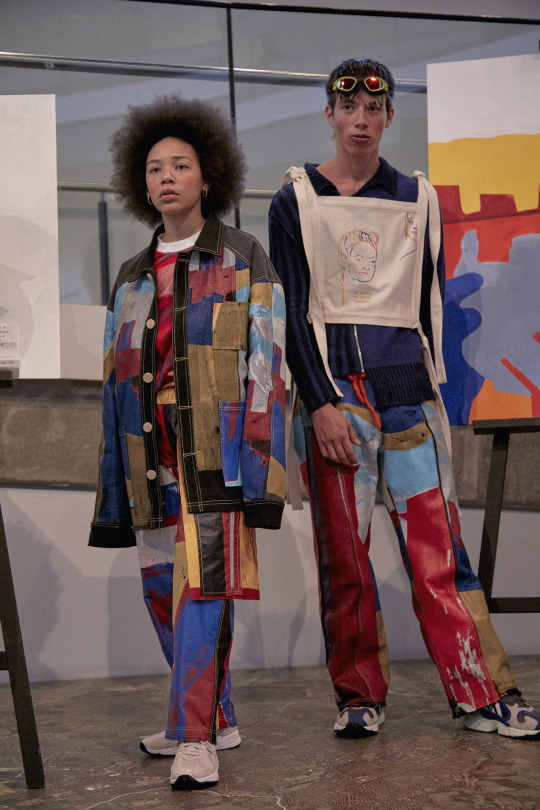
Bethany began her career working part-time at a fashion magazine but she decided to pursue fashion design, starting with a fine art foundation in Brighton, followed by menswear fashion design at the London College of Fashion. Alongside her studies, the young designer also volunteered at homeless shelters and food kitchens in Brighton, a move that ignited the spark to effect social change with her work.
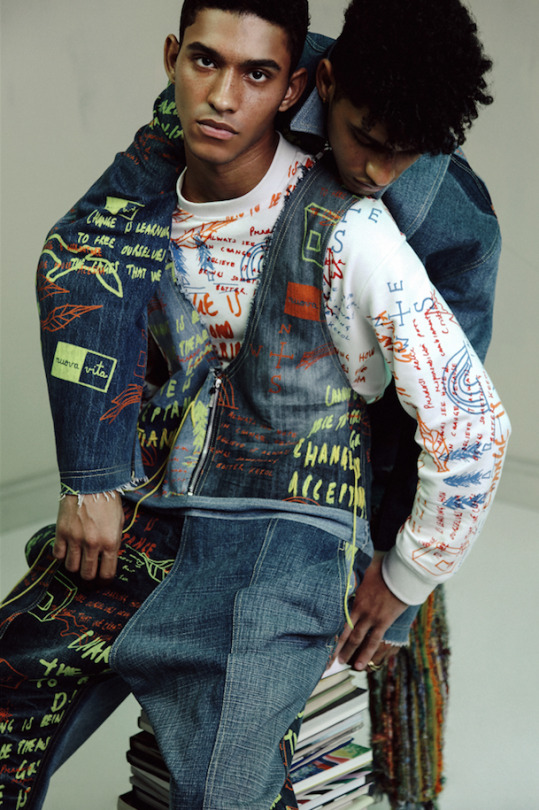
She founded her fashion label in 2017 and chose to source book waste, second-hand denim and hand-woven textiles to create 100 percent recycled garments for her projects. She has collaborated with the Vauxhall Food Bank, The Mobile Library Charity and the Adelaide House women’s shelter, providing employment for female inmates and casting models from the TIH homeless modelling agency. In her work, Bethany casts light on issues such as youth homelessness and hidden hunger in society. Her collections are stocked by Farfetch, Galeries Lafayette Paris, Dune in Tokyo and Odd92 in New York. Williams donates a sizable portion of profits to the charities involved.
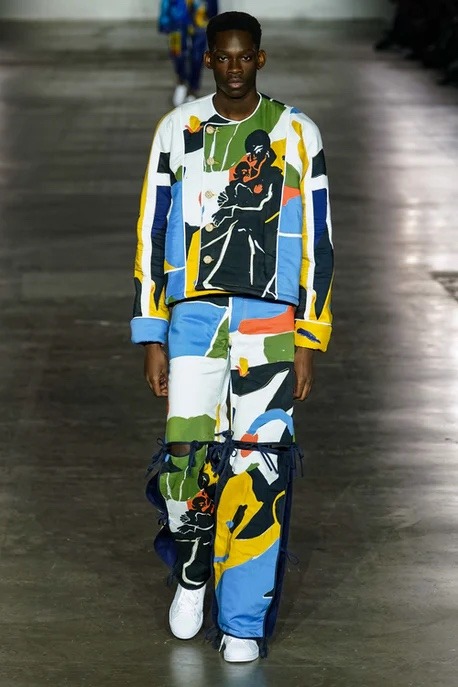
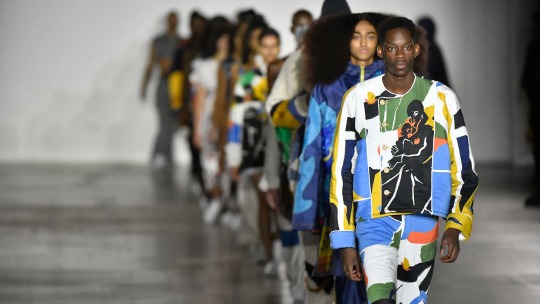
I really love her unique use of colours and materials. Below are two of my favourite pieces made by her. I’d honestly wear those trousers, I think there so nice! And I love the fact the bottom half is detachable and turn into shorts, it’s such a clever idea.

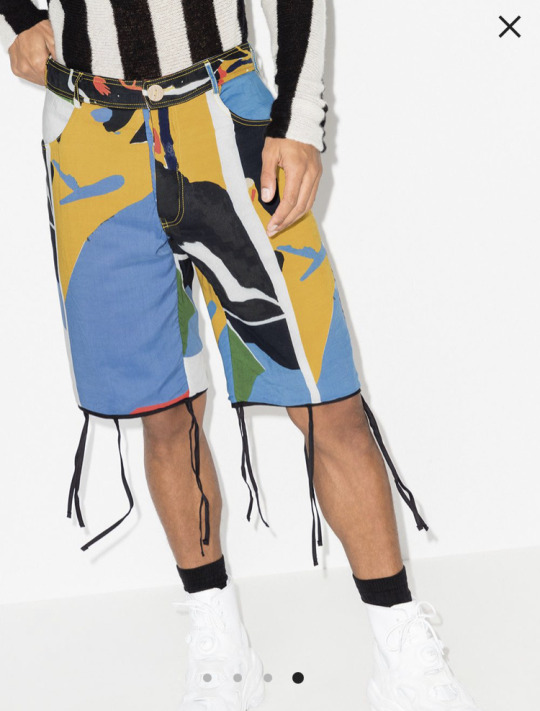
Bethany said last year that the reason she loves wool and incorporates it into her brand is because it’s a natural fibre and she’s interested in finding new ways to repurpose end wool. Which I think is amazing as well as the garments she makes with wool. This outfit looks amazing and so comfortable!
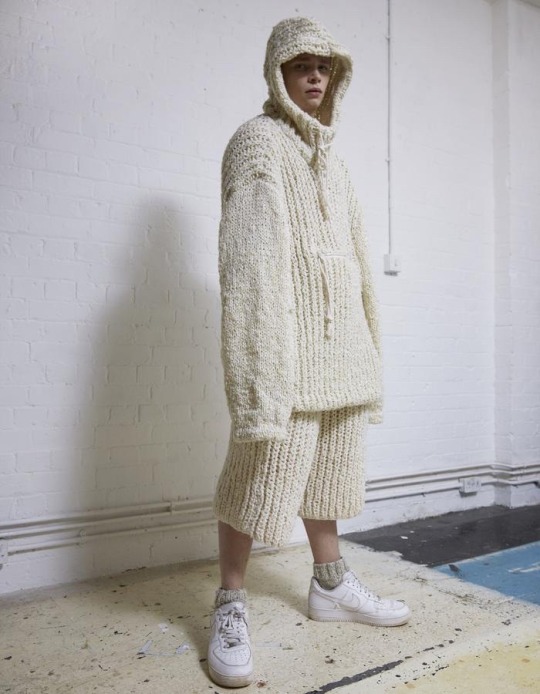
0 notes
Text
Importance of Mattress Recycling Adelaide and What Is Involved In It
The concerns related to out ecosystem, mother earth, nature, etc., is seen everywhere and this concern actually has helped a lot in popularising the concept of mattress recycling Adelaide. People across the globe have realised the multiple benefits of getting mattress recycling services to get them recycled rather than leaving them at landfill sites. There are numerous drawbacks of abandoning mattresses at landfill sites and some of them have been discussed here.
They Stick Around for Many Years
A number of materials used in making mattresses are biodegradable, but they take years and years to biodegrade and in such conditions, they continue to live like a burden on these sites.
For example - natural textiles like cotton and wool, wood and natural latex may decompose in a couple of years, while synthetic fabrics, foams, metals and plastics can hang around for decades, even centuries.

They Can Contribute to Ground Pollution
This goes unsaid that until they get decomposed entirely, they will be a burden on the earth and also on air, as they will continue to pollute both earth as well as air.
This is generally because these mattresses contain several substances that can be harmful, if exposed to the nature for too long like bleaches, fungicides in fabrics, flame retardants, petrochemicals in foams, etc.
They Contribute to Greenhouse Gas Emissions
According to the companies known as mattress recyclers, one more drawback of not recycling is that until they get decomposed entirely, they will continue to contribute to greenhouse gas emissions.
This mainly include methane and carbon dioxide and both of them are extremely harmful not just for humans, but for the nature as well.

How Is Mattress Recycling Done?
Foams and plastics are washed, shredded, processed and often recycled for applications like carpet padding.
Cotton flock and wool can be cleaned, processed and used as yarn or recycled textiles.
Lower-grade fabrics are often processed and sold for use in vehicle matting and interiors.
Metals from frames and springs are melted and used in a number of alternative products.
·Wood can be chipped and used as mulch or burned as fuel.
#Mattress Recycling#Mattress Recycling Services#Mattress collection & recycling#Mattress Recycling Adelaide#Mattress Recycling process#Home Rubbish Removal#Mattress Foam Recycles#Mattress synthetic fabrics#Bulk Waste Collection#Waste Removal Adelaide
0 notes
Text
Revolutionizing Sustainability: Textile Recycling in Adelaide
Discover how textile recycling in Adelaide is transforming the city's approach to sustainability. By repurposing old fabrics, Adelaide is reducing waste and promoting a circular economy. Learn how local initiatives and community efforts are making a significant impact, and find out how you can contribute to this eco-friendly movement. Join us in supporting a greener future through innovative textile recycling practices.
Visit: https://terresarecycling.com/textile-recycling-adelaide
0 notes
Text
Efficient Strategies for Textile Recycling in Adelaide: Making the Most of Unwanted Clothing
In a world increasingly conscious of environmental sustainability, one area often overlooked is textile waste. Every year, a significant amount of clothing ends up in landfills, contributing to environmental degradation. However, with the rise of textile recycling initiatives, such as those by TERRESA Recycling, Adelaide residents now have sustainable solutions to manage unwanted clothing more responsibly.
Understanding the Importance of Textile Recycling
Textile recycling in Adelaide plays a crucial role in reducing waste and conserving resources. The traditional "take, make, dispose" model is no longer sustainable. Hence, the need for efficient strategies to recycle textiles has become paramount. TERRESA Recycling acknowledges this need and offers accessible avenues for textile recycling across Adelaide.
TERRESA Recycling's Approach to Textile Recycling
TERRESA Recycling stands as a beacon for responsible textile waste management in Adelaide. With strategically located collection points, TERRESA Recycling provides an easy and efficient way for locals to recycle their unwanted clothing. By simply dropping off old clothes at these designated points, residents contribute to a sustainable solution that extends the lifecycle of textiles and minimizes waste.

The Impact of Textile Recycling on the Environment
Participating in textile recycling in Adelaide has far-reaching positive impacts. By recycling unwanted clothing, individuals actively contribute to reducing the burden on landfills. Moreover, it conserves resources by repurposing materials, reducing the need for fresh production. TERRESA Recycling's initiatives facilitate this process, turning unwanted garments into reusable materials, thereby contributing to a circular economy.
Join the Movement Towards Sustainable Textile Recycling
By embracing textile recycling in Adelaide with TERRESA Recycling, individuals take a meaningful step towards environmental sustainability. The process is simple and impactful. Instead of discarding clothing items, consider dropping them off at TERRESA Recycling's collection points, where they can be transformed into new materials, minimizing waste and supporting a greener future for Adelaide.
In conclusion, efficient strategies for textile recycling in Adelaide, led by TERRESA Recycling, empower individuals to play a pivotal role in environmental conservation. Join the movement today and be a part of the solution for responsible textile waste management in Adelaide.
1 note
·
View note
Text
These Are The Very Best Of Australia’s Handcrafters and Makers!
These Are The Very Best Of Australia’s Handcrafters and Makers!
TDF Design Awards
Lucy Feagins

Liam Fleming, Graft Vase Series. Photo – Grant Hancock. Siân Boucherd, Oyster Shell. Photo – Yvonne Doherty.
Liam Fleming, Graft Vase Series
Though appearing separate, each mould-blown elements of these cubic glass vases is actually a distinct part, fused with another to create a single, stacked body. To make these asymmetrical, geometric pieces, Liam Fleming uses the traditional incalmo (meaning ‘graft’ in a Venetian dialect) technique, wherein two or more elements made of different coloured glass are melded together to create one solid vessel. This process allow Liam to experiment with colour combinations in a contemporary composition, while still retaining a continuous form.
Liam draws on the colour theories of twentieth century artists Wassily Kandinsky, Paul Klee and Piet Mondrian to explore how colour and form can aesthetically express the tempo of music. He makes all pieces with his assistant, Alex Valero, in Adelaide!
Siân Boucherd, Oyster Shell
This decorative sculpture is woven from organic fibres and mimics the flow of moving water.
In this self-initiated project, Siân Boucherd uses traditional basketry techniques to create a contemporary, amorphous form. The art object was made from raw raffia, hemp, sisal and wool which had been ethically or sustainably sourced. The soft, billowing shape recalls ancient natural formations which have been chiselled with the ebb and flow of time.

Tantri Mustika, Lithify. Photo – Boby Corica. Szilvassy, Aether. Photo – Emily Weaving.
Tantri Mustika, Lithify
The Melbourne-based ceramicist’s collection of opulent ceramic vases is a celebration of the complex chemical transformation that occurs when clay becomes solid rock. This process of turning sediment into stone is called lithification.
Tantri Mustika‘s series of large works were made using coils – a freeform sculpting technique in which lengths of pliable clay are wound into rings and stacked atop another to form the body of the vessel. Tantri initiated this ancient building technique alongside a process of clay handstaining, to illuminate the natural texture of her work. In this trip of ancient techniques, she aims to modernise a less popular side of her craft.
Szilvassy, Aether
Shari Lowndes of Szilvassy draws on science, Classical philosophy and cultural notions of place to explore spirituality through material form.
Inspired by her family’s migration to Australia in the wake of the 1952 coup d’état in Egypt, the Melbourne based ceramicist has discovered a deep connection to the Australian landscape. Inspired by this attachment, Shari has created 12 delicate, functional forms to express her relationship with the natural world. The earthen qualities of the Aether collection are explored through subtle variations in terracotta tones.

Daisy Watt and Samantha Seary, Holding Light. Photo – Daisy Watts.
Daisy Watt and Samantha Seary, Holding Light
This project by Daisy Watt and Samantha Seary tests the strength of two fragile materials when fused together as one.
In order to explore the intersection between cloth and glass, the pair of textile artists have created a handwoven textile of multi-layered cloth, which encases hand-cut and copper-wrapped coloured glass pieces within its delicate pockets. The construction of this new fabric compound is a study in raw materiality.

James Lemon, Pest Chairs. Photo – James Lemon. Kirsten Perry, The Lost Homes of Soft Boiled Beings. Photo – Kirsten Perry.
James Lemon, Pest Chairs
Created as part of an exhibition challenging designers to think about more radical solutions around recyclability and waste, James Lemon’s Pest Chairs offer new material and aesthetic possibilities within design.
Handbuilt from stoneware clay, glaze and toothpaste (!), these large-scale ceramic sculptures are an homage to humble yet sophisticated insect architecture such as anthills, termite mounds and beehives. These sculptures aim to shift the focus from the ‘humanness’ of design to preexisting natural structures.
Kirsten Perry, The Lost Homes of Soft Boiled Eggs
Influenced by mollusc shells and coral, Kirsten Perry’s underwater-inspired ceramic vessels are an experiment in texture, technique and scale. Using her own slip-cast plaster mouldings and a mid-fire glaze, Kirsten is able to create shapes otherwise impossible in handmade ceramics. Every fold, cut, slice and impression can be seen on the surface.

Georgina Proud, Glass Houses. Photo – Georgina Proud.
Georgina Proud, Glass Houses
Following her return from a ceramics residency in Japan, Georgina Proud set out to include found objects within her clay creations. In a bid to recreate the sea glass she uncovered while scavenging at the beach, she crafted smoothed glass shards from bottles found in her own recycling waste, to insert into her designs. She added pieces of this fake sea glass to her fine white porcelain forms, which then melted during the firing process to create a different coloured glaze.
By incorporating foraged rocks, ash and glass in her clay bodies, Georgina’s series of simple ceramic vessels highlights the harmonic effect of clashing materials and glazes.
Nicolette Johnson, Assemblage
It’s no secret that we’re BIG fans of Nicolette Johnson’s work, but recently, she’s taken her practice to another level.
Desperate to unlock the creative part of her brain that had stagnated during the lockdown period earlier this year, Nicolette began moulding shapes and objects out of clay to stick to small, hand thrown vases. These working pieces eventually became the larger, relic-like Assemblage vases.
The collection of coiled stoneware vessels with attached hand-formed sculptures are a continuation of her experimental oeuvre, yet something totally new unto themselves. Nicolette draws from the motifs of surrealist and constructivist art movements to create her designs.

Cut Throat Knives, Imprint. Photo – Rebecca Newman. Tjunkaya Tapaya of Tjanpi Desert Weavers, Tjanpi Teapot. Photo – Isobel Egan.
Cut Throat Knives, Imprint
From the combined craftsmanship of a bladesmith and a leathersmith, Cut Throat kitchen knives are superbly balanced and customised down to the handle colour for each individual buyer. The Imprint collection is a series of bespoke metal utensils made from steel and polished timber, with the infinite options for size, colour and shape customisation. Each knife comes with a handmade leather sheath.
Tjunkaya Tapaya of Tjanpi Desert Weavers, Tjanpi Teapot
Tjanpi Desert Weavers is an Indigenous governed and directed social enterprise of the Ngaanyatjarra, Pitjantjatjara and Yankunytjatjara Women’s Council (NPYWC), which represents over 400 women artists from the NPY lands (a region across the Northern Territory, South Australia and Western Australia).
Tea is ever-present in the lives of Anangu (Aboriginal people) across the NPY lands. When making art, telling stories, facilitating a meeting, undertaking cultural ceremonies, or holding sorry camps – a fire is made and everyone drinks tea together. The teapot is where activities begin and end, and has become an object of great importance to the social fabric of community life.
Tjunkaya Tapaya’s ‘Tjanpi Teapot’ provides a playful representation of this important element of Anangu life. Her unique expression, form and exquisite use of colour demonstrates her mastery of weaving with native grasses and aptitude for funnelling social reflection through her craft.
We’re proud to partner with heritage Australian brand Laminex to realise The Design Files + Laminex Awards program 2020. Laminex is Australia’s leading supplier of modern laminates, quality engineered stone, timber panelling and more. Find out more here.
Winners of the The Design Files + Laminex Design Awards 2020 + Laminex will be announced November 5th!
1 note
·
View note